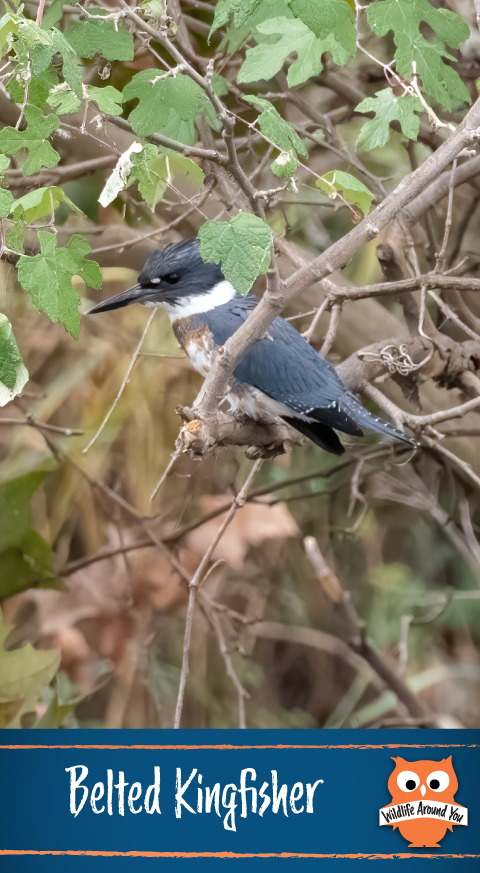Identification
You’ll probably hear it’s loud call before you see it.
Blue-grey with a white collar. Females have a brownish belly band and flanks. They have a large head in comparison to their bodies, and short legs.
11-13 inches long
5-6oz
Wingspan 18-23 inches
Habitat
Belted Kingfishers are common along streams, rivers, ponds, lakes and shorelines of North America.
They will winter over in areas where the water doesn’t freeze so they never lose access to food.
Hunting water has to be clear and uncloudy so they can see the fish below the surface.
Nesting
They nest in burrows, usually near water, that they dig into soft soil along the banks that are free from vegetation that can make it hard to dig. Sometimes they locate it in a landfill, sand pit, gravel pit, etc. They make it high up on the bank where the risk of floodwaters is low. Male and female take turns digging.
Usually takes 3-7 days to complete(sometimes up to 3 weeks). The burrow extends 3-6 feet into the bank, sloping up so water won’t collect inside, and ends with a 8-12 in chamber
Behavior
Spend a lot of time perched along waterways, or on telephone wires and poles.
You can also hear their call as they fly up and down the waterways in search of fish.
They are very territorial.
Monogamous within each breeding season, but form new pairs every year.
Male feeds the female while courting her.
Offspring
Clutch size: 5-8 eggs
Broods:1-2
Egg length: 1-1.5 inches
Incubation period-22-24 days
Nestling Period 27-29 days
Both parents share the incubation period and share feeding the young. Requires on average 8ish fish per day per bird.
As nestlings they can digest the bones and scales of the fish. As they mature they begin disgorging pellets with those contents.
Predators
Hawks, Mammals, snakes
Diet
Eat mostly fish less than 4-5 inches long. May also eat the occasional crayfish or othe crustaceans, mollusks, insects or small prey animals or even berries if needed.
Catches fish by diving directly into water from a perch, or from hovering over the water.
Once it catches a fish it returns to a perch and pounds the prey against the perch before swallowing it head first.
Fun Facts
Sometimes they will show up to backyards that contain ponds or goldfish pools to the dismay of homeowners.
Group of belted kingfishers are collectively known as a “crown” and a “rattle” of kingfishers.
Appeared on the Canadian 1986 series $5 note
Sometimes swallows share their tunnels, digging out small rooms off from the main tunnel. Sometimes they just chase the swallows away.
They will dive into the water to keep from getting caught by hawks

